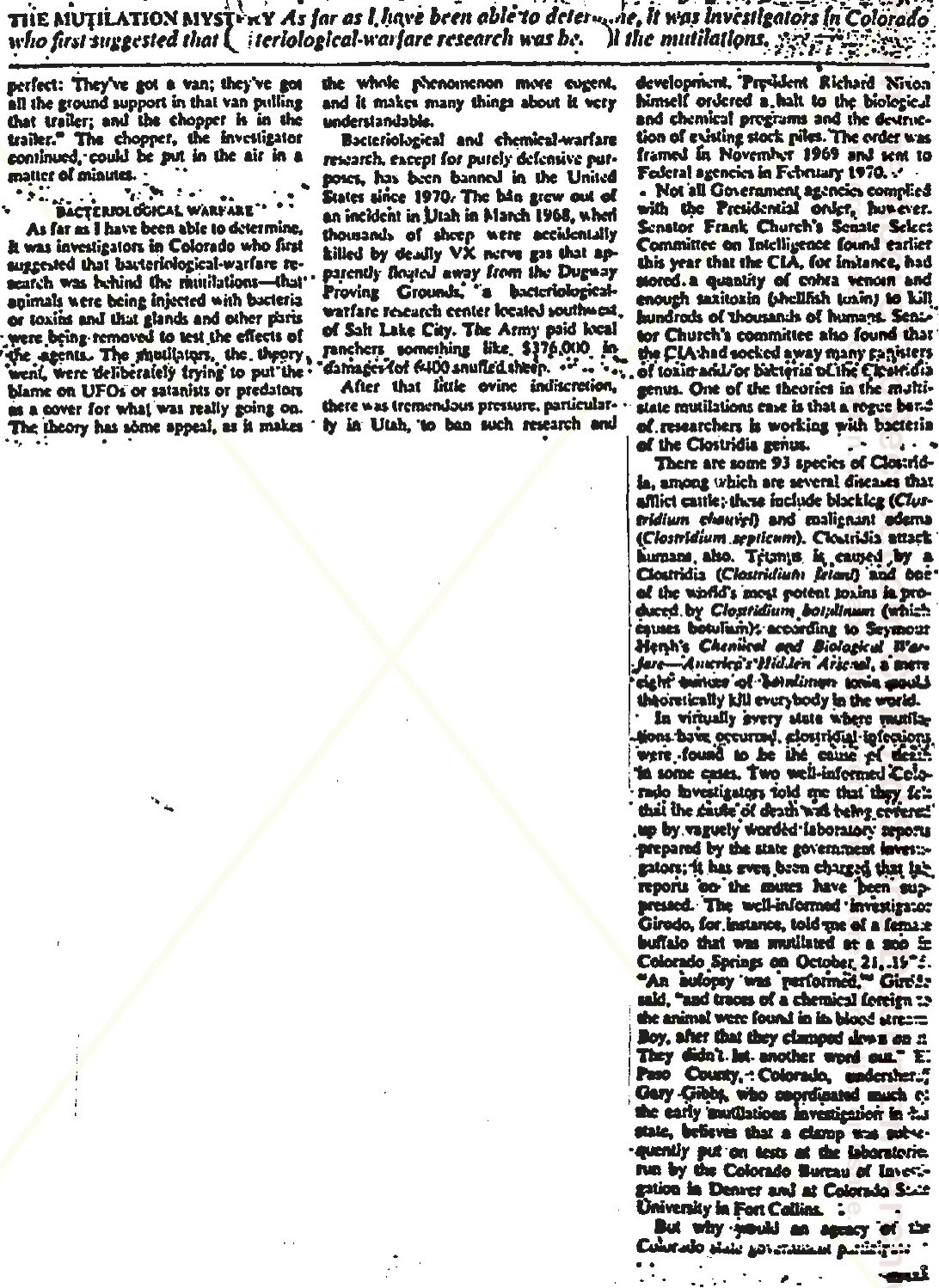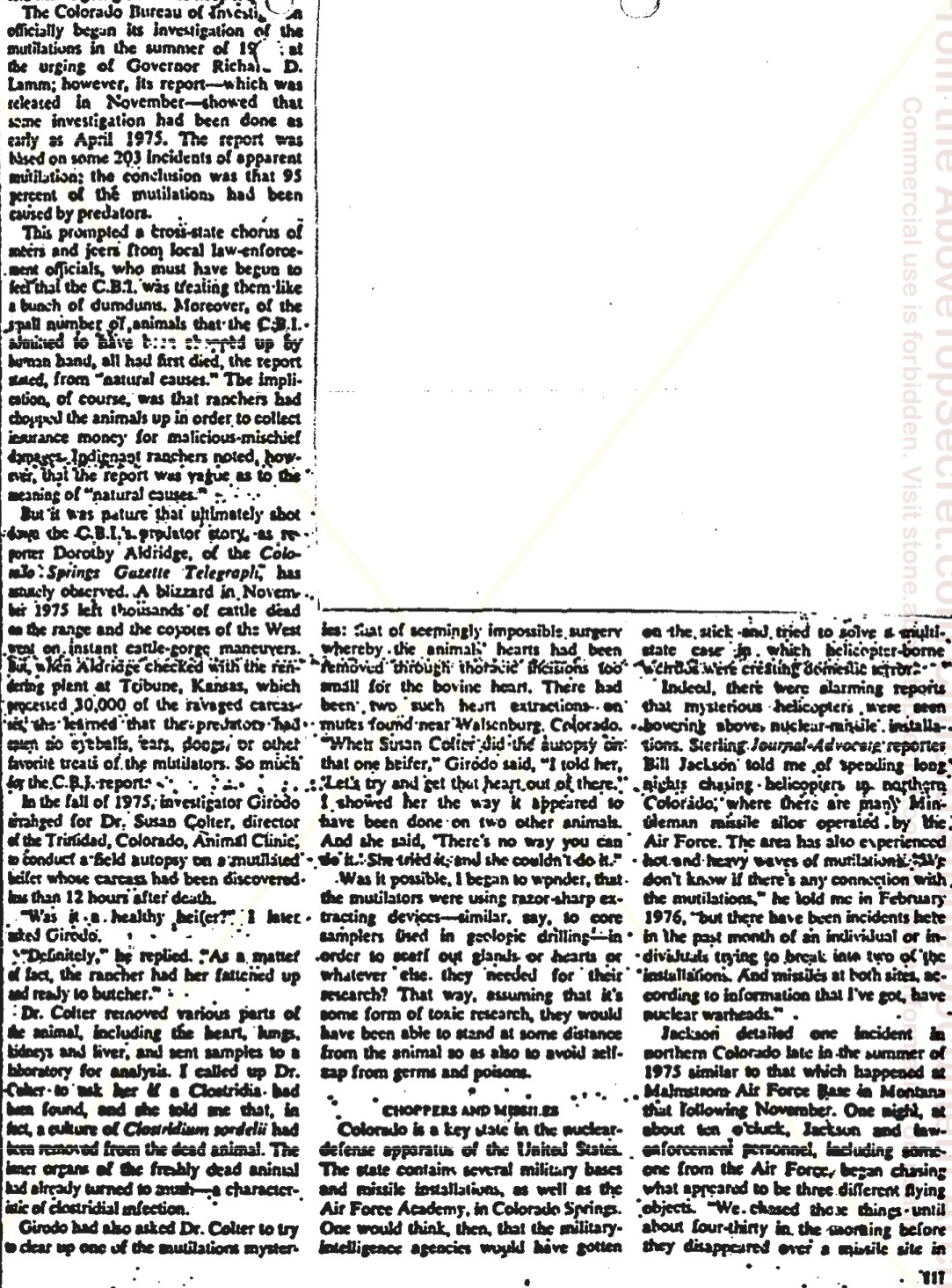As far as I have been able to determine, it was investigators in Colorado who first suggested that bacteriological warfare research was behind the mutilations—that animals were being injected with bacteria or toxins and that glands and other parts were being removed to test the effects of the agents. The mutilators, the theory went, were deliberately trying to put the blame on UFOs or satanists or predators as a cover for what was really going on. The theory has some appeal, as it makes the whole phenomenon more cogent, and it makes many things about it very understandable.
Bacteriological and chemical warfare research, except for purely defensive purposes, has been banned in the United States since 1970. The ban grew out of an incident in Utah in March 1968, where thousands of sheep were accidentally kikked by deadly VX nerve gas that apparently floated away from the Dugway Proving Grounds, a bacteriological-warfare research center located southwest of Salt Lake City. The Army paid local ranchers something like $376,000 in damages for 6400 snuffed sheep.

After that little ovine indiscretion, there was tremendous pressure, particularly in Utah, to ban such research and development. President Richard Nixon himself ordered a halt to the biological and chemical programs and the destruction of existing stock piles. The order was framed in November 1969 and sent to Federal agencies in February 1970.
Not all Government agencies complied with the Presidential order, however. Senator Frank Church's Senate Select Committee on Ingelligence found earlier this year that the CIA, for instance, had stored a quantity of cobra venom and enough saxitoxin (shellfish toxin) to kill hundreds of thousands of humans. Senator Church's committee also found that the CIA had socked away many canisters of toxin and/or bacteria of the Clostridia genus. One of the theories in the multi-state mutilations case is that a rogue band of researchers is working with bacteria of the Clostridia genus.
There are some 93 species of Clostridia, among which are several diseases that afflict cattle; these include blackleg (Clostridium chauveoi) and malignant adema (Clostridium septicum). Clostridia attack humans also. Tetanus is caused by a Clostridia (Clostridium tetani) and one of the world's most potent toxins is produced by Clostridium botulinum (which causes botulism); according to Seymour Hersh's Chemical and Biological Warfare—America's Hidden Arsenal, a mere sight bearkoes of Clostridium scrin would theorically kill everybody in the world.
In virtually every state where mutilations have occured, clostridial infections were found to be the cause of death in some cases. Two well-informed Colorado investigators told me that they felt that the cause of death was being covered up by vaguely worded laboratory reports prepared by the state government investigators; it has even been charged that lab reports on the mutes have been suppressed. The well-informed investigator Girodo, for instance, told me of a female buffalo that was mutilated at a ranch in Colorado Springs on October 21, 1975. "An autopsy was performed," Girodo said, "and trace of chemical foreign to the animal were found in its blood stream Boy, after that they clamped slows on it. They didn't let another woed out." El Paso County, colorado, undersheriff Gary Gibbs who coordinated much of the early mutilations investigation in his state, believes that a cleanup was subsequently put on tests at the laboratories run by the Colorado Bureau of Investigation in Denver and at Colorado State University in Fort Collins.
But why would an agency of the Colorado state government purinigsns.

The Colorado Bureau of Investigation officially began its investigation of the mutilation in the summer of 1975 at the urging of Governor Richard D. Lamm; however, its report—which was released in November—showed that some investigation had been done as early as April 1975. The report was based on some 203 incidents of apparent mutilation; the conclusion was that 95 percent of the mutilations had been caused by predators.
This prompted a cross-state chorus of meers and jeers from local law-enforcement officials, who must have begun to feel that the C.B.I. was treating them like a bunch of dumdums. Moreover, of the small number of animals that the C.B.I. submitted to have been chopped up by human hand, all had first died, the report stated, from "natural causes." The implication, of course, was that ranchers had chopped the animals up in order to collect insurance money for malicious-mischief damages. Indignant ranchers noted, however, that the report was vague as to the meaning of "natural causes."
But it was nature that ultimately shot down the C.B.I's predator story, as reporter Dorothy Aldridge, of the Colorado Springs Gazette Telegraph, has acutely observed. A blizzard in November 1975 left thousands of cattle dead on the range and the coyotes of the West vent on instant cattle-gorge maneuvers. But, when Aldridge checked with the rendering plant at Tribune, Kansas, which processed 30,000 of the ravaged carcasses, she learned that the predators had eaten no eyeballs, ears, doogs, or other favorite treats of the mutilators. So much for the C.B.I. report.
In the fall of 1975, investigator Girodo arranged for Dr. Susan Colter, director of the Trinidad, Colorado, Animal Clinic, to conduct a field autopsy on a mutilated heifer whose carcass had been discovered less than 12 hours after death.
"Was it a healthy heifer?" I later asked Girodo.
"Definitely," he replied. "As a matter of fact, the rancher had her fattened up and ready to butcher."
Dr. Colter removed various parts of the animal, including the heart, lungs, kidneys and liver, and sent samples to a laboratory for analysis. I called up Dr. Colter to ask her if a Clostridia had been found, and she told me that, in fact, a culture of Clostridium sordelii had been removed from the dead animal. The inner organs of the freshly dead animal had already turned to amush—a characteristic of clostridial infection.
Girodo had also asked Fr. Colter to try to clear up one of the mutilations mysteries: that of seemingly impossible surgery whereby the animals hearts had been removed through thoracic incisions too small for the bovine heart. There had been two such heart extractions on mutes found near Walsenburg, Colorado. "When Susan Colter did the autopsy on that one heifer," Girodo said, "I told her, 'Let's try and get that heart out of there." I showed her the way it appeared to have been done on two other animals. And she said, 'There's no way you can do it."
Was it possible, I began to wonder, that the mutilators were using razor-sharp extracting devices—similar, say, to core samplers used in geologic drilling—in order to scalt out glands or hearts or whatever else they needed for their research? Thay way, assuming that it's some form of toxic research, they would have been able to stand at some distance from the animal so as also to avoid self-sap from germs and poisons.